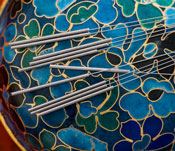Researchers from the University of California at San Francisco have determined that acupuncture stimulation reduces pain. The acupuncture induced pain relief was determined to be the equivalent of a moderate dose of morphine. Dr. Goddard from the renown University of California, Department of Oral and Maxillofacial Surgery Department conducted a laboratory experiment to measure the effects of needling acupuncture point ST36, located on the lower leg.
 Acupuncture NeedlesA Seirin 30mm, 0.20 gauge acupuncture needle was applied to a laboratory rat and the the jaw opening reflex technique was used to measure the results of an electrical impulse applied to the lower incisor. The jaw opening reflex is an accepted measure of pain in lab rat experimentation. The study measured a 23.2% decrease in jaw opening reflex after one minute and a 30% decrease after 15 minutes. A 30% decrease is the pain relief equivalent to a moderate dose of morphine.
Acupuncture NeedlesA Seirin 30mm, 0.20 gauge acupuncture needle was applied to a laboratory rat and the the jaw opening reflex technique was used to measure the results of an electrical impulse applied to the lower incisor. The jaw opening reflex is an accepted measure of pain in lab rat experimentation. The study measured a 23.2% decrease in jaw opening reflex after one minute and a 30% decrease after 15 minutes. A 30% decrease is the pain relief equivalent to a moderate dose of morphine.
Acupuncture Shop Talk
Acupuncture point ST36 (Zusanli, Leg Three Measures) has a function within Traditional Chinese Medicine (TCM) to activate the Stomach (Yangming) channel and relieve pain. Although more commonly known for its ability to tonify Qi, Blood and Yin, ST36 is indicated for the treatment of leg, back, chest, breast, abdominal, eye and knee pain. Headaches are also indicated. In general, ST36 is indicated for pernicious cold damp painful obstruction related disorders.
ST36 treats channel specific pain. The research of this study measured the analgesic effects of ST36 for electrically induced pain of the lower incisor. It is not surprising that ST36 was found effective given that the channel runs along the gums and jaw. The primary Stomach channel begins at acupuncture point LI20 beside the nose and ascends to the root of the nose where it intersects UB1. Next, the Stomach channel descends along the lateral aspect of the nose and enters the upper gum and joins with acupuncture point DU26. The channel then circles around the corner of the mouth and meets with CV24 at the mentolabial groove. Next, the Yangming channel follows the angle of the jaw and runs upward in front of the ear. At this point, the primary channel traverses other regions of the body.
The divergent channel, however, diverges from the primary channel at the thigh, enters the abdomen, connects with the stomach, disperses in the spleen and then ascends to the heart and follows the esophagus to the mouth. Next, the divergent channel continues upward beside the nose and reaches the eye before rejoining the primary channel. The Luo-Connecting channel has a branch that ascends along the lateral margin of the tibia to the thigh, trunk and eventually meets with other Yang channels at the top of the head. Another branch separates in the neck and connects with throat. The combination of divergent, Luo and primary channel connections to the head, mouth, jaw and gums support the findings of the research.
Reference:
Goddard, Greg. "Acupuncture (ST 36) Reduces Jaw Open Reflex in a Rat: A Pilot Study." (2013).

